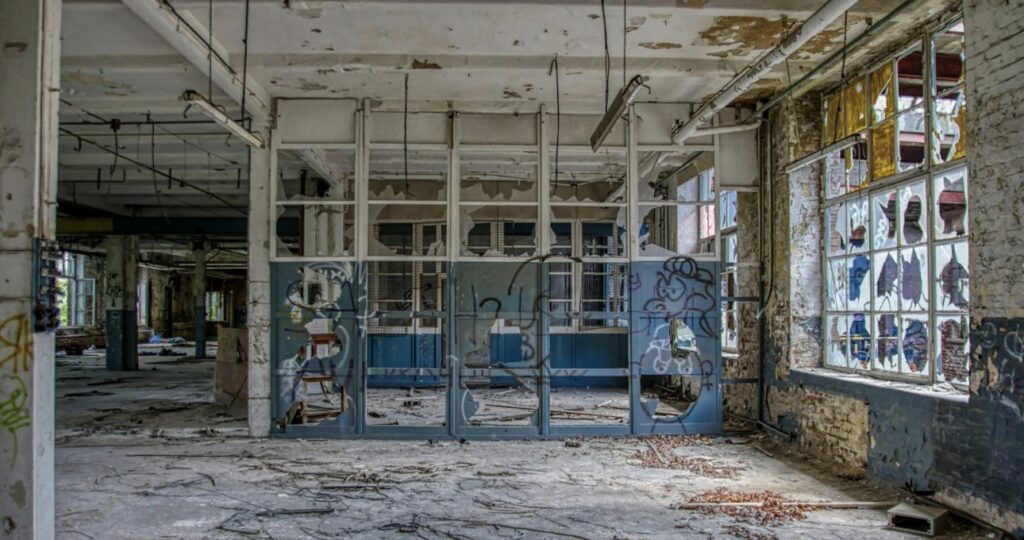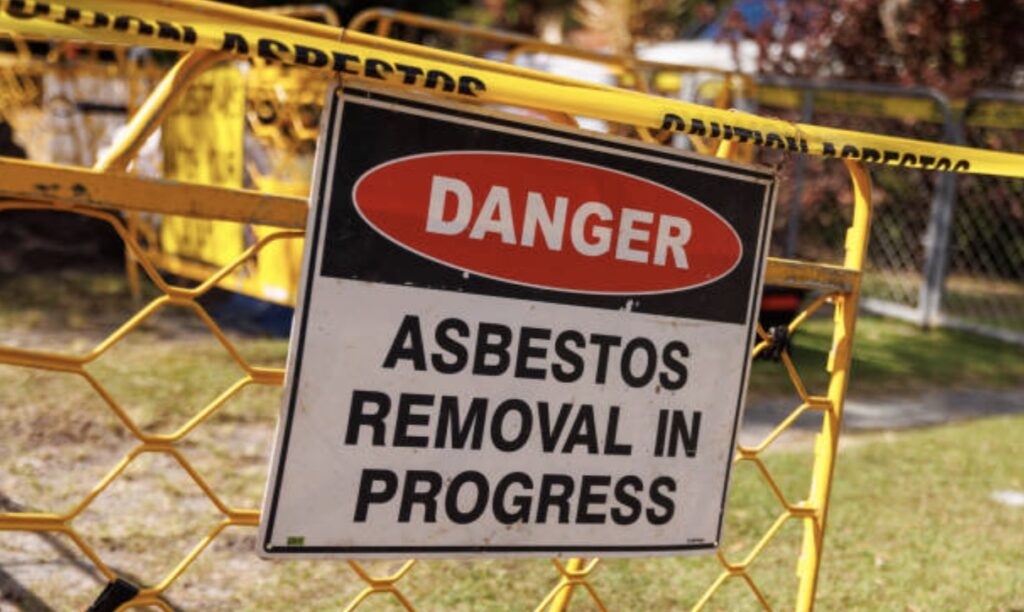Asbestos is dangerous because its microscopic fibres can become airborne and lodge in the lungs, leading to serious and often fatal diseases. Asbestos exposure causes chronic inflammation, scarring, and genetic mutations that may develop into asbestosis, lung cancer, or mesothelioma.
Although asbestos was banned in the UK in 1999, its presence in older buildings means the danger hasn’t passed. Renovations, demolitions, or even minor disturbances in homes built before 2000 can release asbestos fibres.
This article explains how asbestos affects health, identifies those most at risk, and outlines current safety and legal controls in place.
Understanding Asbestos Types and Hazards
Here’s a comprehensive classification of asbestos:
| Mineral Family | Asbestos Type | Fibre Shape | Common Colour | Typical Uses |
|---|---|---|---|---|
| Serpentine | Chrysotile (White) | Curly, flexible fibres | White to grey | Roof sheets, floor tiles, wall cladding |
| Amphibole | Amosite (Brown) | Straight, brittle fibres | Brown to grey | Insulation boards, pipe lagging, ceiling panels |
| Crocidolite (Blue) | Thin, needle-like fibres | Blue | Spray coatings, cement pipes, gaskets | |
| Anthophyllite | Straight fibres | Brownish-grey | Rare, sometimes in vermiculite or talc | |
| Tremolite | Fine, sharp fibres | White to greenish | Contaminant in talc, plaster, vermiculite | |
| Actinolite | Needle-like fibres | Green to dark grey | Rarely used, found in contaminated products |
Inhaled asbestos fibres bypass the body’s natural defences and lodge in lung and pleural tissues. Once embedded, these fibres cause chronic inflammation, which leads to scarring (fibrosis), cellular damage, and DNA mutations.
Over time, such damage from asbestos can progress to debilitating diseases such as asbestosis or fatal malignancies like mesothelioma.

Exposure Pathways and At-Risk Populations From Asbestos
Occupational exposure remains the leading source of asbestos-related illness. Workers in construction, shipbuilding, insulation, and demolition are especially at risk, particularly during activities like sanding old asbestos boards, removing pipe lagging, or working in boiler rooms without adequate personal protective equipment (PPE).
Environmental and secondary exposures also pose serious risks. In homes, deteriorated asbestos siding, roofing, or vermiculite insulation can release fibres into the air. Additionally, family members of workers may be exposed to asbestos dust brought home on clothing, tools, or vehicles.
DIY enthusiasts are another risk group—drilling into textured coatings, sanding floor tiles, or removing ceiling panels from older homes can unknowingly disturb ACMs and release dangerous asbestos fibres.
Asbestos Health Risks and Disease Profiles
Asbestos-related illnesses include both cancerous and non-malignant conditions, as classified in the following table:
| Condition | Classification | Hazards |
|---|---|---|
| Asbestosis | Non-Cancerous | Chronic lung scarring; symptoms include breathlessness, cough, and fatigue |
| Pleural Plaques | Localised pleural thickening; usually asymptomatic | |
| Pleural Thickening | Scarring of the pleural lining leading to restricted breathing and chest pain | |
| Mesothelioma | Cancerous | Aggressive cancer of the pleura or peritoneum; typically fatal |
| Lung Cancer | Risk is significantly elevated with asbestos exposure, especially in smokers | |
| Laryngeal Cancer | Cancer of the voice box | |
| Ovarian Cancer | Found in occupational and environmental exposure cases |
Asbestos Risk Modifiers and Synergistic Factors
The risk of developing asbestos-related disease depends heavily on the intensity and duration of exposure.
Short-term, high-level asbestos exposure (e.g., during industrial accidents) can be just as harmful as chronic, low-level exposure over decades. Smoking significantly increases the risk of lung cancer in those exposed to asbestos, creating a synergistic effect that multiplies overall danger.
Individual susceptibility varies—factors like age at first exposure, genetic makeup, and pre-existing lung conditions can influence asbestos disease development and severity.
Asbestos Detection and Diagnosis
Asbestos detection and diagnosis involves a structured series of clinical and diagnostic steps designed to identify exposure-related conditions, including:
- Clinical history assessment – Focuses on past occupations, home renovation exposure, and secondary contact with asbestos through family members.
- Risk indicator review – Flags potential exposure scenarios such as insulation work, shipyard employment, or residence in pre-2000 properties.
- Imaging techniques – Includes chest X-rays for scarring and pleural changes and high-resolution CT scans for early-stage or subtle abnormalities.
- Lung function testing – Uses spirometry and diffusion capacity to evaluate respiratory efficiency and detect impairment from fibrosis or thickening.
- Emerging biomarker studies – Investigates blood- and breath-based markers as potential tools for earlier, non-invasive diagnosis (not yet standard practice).
Asbestos Prevention and Control Strategies
The UK Control of Asbestos Regulations 2012 outline responsibilities for duty holders, employers, and contractors.
The Health and Safety Executive (HSE) provides comprehensive guidance for managing asbestos in workplaces and homes. In professional settings, the control hierarchy includes elimination, substitution, engineering controls (e.g., air extraction), PPE, and administrative controls for preventing issues linked to asbestos.
Safe asbestos management practices include:
- Controlled demolition methods – Limits fibre release by using dust-suppression techniques during structural work.
- Encapsulation of stable ACMs – Applies protective sealants to asbestos materials in good condition to contain fibres.
- Real-time air monitoring – Continuously tracks airborne asbestos levels to verify safe conditions during removal or maintenance.
- Avoidance of unnecessary disturbance – Advises against touching or moving asbestos unless absolutely required.
- Pre-renovation property inspection – Essential for homes built before 2000 to identify potential ACMs before starting work.
- Professional consultation – Recommends engaging licensed contractors for surveys, sampling, and remediation.
- Accredited lab testing – Ensures samples are analysed by UKAS-accredited laboratories for accurate asbestos identification.
Professional Asbestos Removal and Waste Disposal
When asbestos removal is necessary, only licensed contractors should perform the work. Safe asbestos removal involves sealing the area, applying wet techniques to suppress dust, using negative pressure enclosures, and following strict decontamination protocols. After asbestos removal, clearance air testing must confirm that the area is safe for re-entry.

Asbestos waste is classified as hazardous and must be double-bagged, labelled, and documented using a hazardous waste consignment note. Disposal must take place at a licensed landfill equipped to handle asbestos.
In the event of accidental disturbance, the area containing asbestos should be sealed off immediately, and professional help sought without delay.
Legal Responsibilities and Compliance Regarding Asbestos Risk
In the UK, landlords, employers, and property owners all have legal duties to identify and manage asbestos risks.
The law requires asbestos surveys for non-domestic properties and during major refurbishments. These include asbestos management surveys (for ongoing occupancy) and refurbishment/demolition surveys (before invasive works).
Survey findings of any asbestos-related contamination must be documented, stored, and reviewed regularly. When selling or leasing a property, known asbestos must be disclosed, and failure to do so can lead to liability.
